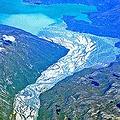 如果氣候暖化造成海平面上升,全世界大約有10%的人口,總共約有6億人,是居住在有水災危機的低地區。科學家說,即使保守估計,在2100年之前海平面至少會上升50公分,而最高的則會上升1公尺。
如果氣候暖化造成海平面上升,全世界大約有10%的人口,總共約有6億人,是居住在有水災危機的低地區。科學家說,即使保守估計,在2100年之前海平面至少會上升50公分,而最高的則會上升1公尺。
上述數據是10日在哥本哈根一項氣候變遷國際科學大會上發表的。科學家說,如果沒有辦法快速實際地減少溫室氣體,即使在最好的情況下,上升中的海平面可能會淹沒低窪的海岸地區,目前有1/10的世界人口居住於此。
這個三天的會議是由國際研究大學聯盟所籌辦,開幕當日有超過2000名的與會者,這個大會收到近乎1600份由70多個國家來的科學文獻,使得這個大會成為世界上最大的跨領域的氣候變遷學術會議。
該會的初步結論會於19日發表,並會彙總成為一份綜合報告於6月出版,丹麥政府將會發給2009年12月參加聯合國氣候變遷大會的與會者──在這場年底的會議上,各國政府預計會討論出一個新的全球氣候協議,與2012年到期的京都議定書銜接。
3月10日當天,科學會議海平面上升議程的主講人、澳洲天氣和氣候研究中心的區奇博士(Dr. John Church)告訴與會者,從最近期的衛星和地面研究顯示,從1993之後,海平面將會持續以每年0.03公分的速度上升,上升速度遠超過20世紀的平均值。
 早先由區奇領導的研究顯示,即使海平面和緩上升50公分,也將會增加海岸洪水的發生次數。最近一次由跨政府氣候變遷小組所做的評估報告裡預估,自2007年開始預計的海平面上升幅度將是18至59公分,但是這份報告表示並沒有將所有造成海平面上升的因素,都包含在當年的計算之內。
早先由區奇領導的研究顯示,即使海平面和緩上升50公分,也將會增加海岸洪水的發生次數。最近一次由跨政府氣候變遷小組所做的評估報告裡預估,自2007年開始預計的海平面上升幅度將是18至59公分,但是這份報告表示並沒有將所有造成海平面上升的因素,都包含在當年的計算之內。
「不確定性主要是來自於冰層對溫暖氣候的反應,以及與海洋之間的交互作用。」加州大學地球系統科學教授瑞格諾(Eric Rignot)教授如此表示,他同時也是NASA的資深研究科學家。
由於大規模地冰河溶解,格陵蘭島和南極洲的冰層造成比預期中更快速的海面上升,如果這樣的趨勢持續,瑞格諾表示可能預見在2100年將有超過1公尺以上的海平面上升。
About 600 million people, or nearly 10 percent of the world's population, live in low-lying areas at risk of flooding as sea levels rise due to climate change, according to research presented today at the International Scientific Congress on Climate Change in Copenhagen.
Even in the lower ranges of current predictions, it looks increasingly likely that sea level rise will be at least 50 cm (19.6 inches) by 2100, scientists told the Congress, and the upper range of sea level rise could be at least one meter (39 inches) by the end of this century
This means that if emissions of greenhouse gases are not reduced quickly and substantially, even in the best case scenario rising seas may inundate low lying coastal areas housing about one in every 10 people on the planet.
Organized by International Alliance of Research Universities, the three-day meeting opened today with more than 2,000 participants. The congress has received almost 1,600 scientific contributions from more than 70 countries, making it one of the world's largest ever interdisciplinary conferences on climate change.
The preliminary conclusions from the congress will be presented Thursday at the closing session and will be developed in a synthesis report to be published in June. The Danish government will give the synthesis report to all participants at the UN Climate Change Conference here in December. At that meeting, governments are expected to finalize a new global climate agreement that will pick up where the Kyoto Protocol leaves off in 2012.
Today, lead speaker in the sea level session, Dr. John Church of the Centre for Australian Weather and Climate Research in Hobart, Tasmania told participants, "The most recent satellite and ground based observations show that sea level rise is continuing to rise at three millimeters per year or more since 1993, a rate well above the 20th century average.
An earlier study led by Church shows that even a modest sea level rise of 50 centimeters will increase the number of coastal flooding events. The last assessment report from the Intergovernmental Panel on Climate Change from 2007 projected a sea level rise of 18 to 59 centimeters (7 to 23 inches). But the report stated that not all factors contributing to sea level rise could be calculated at that time.
The uncertainty was centered on how ice sheets react to the effects of a warmer climate and how they interact with the oceans, explained Eric Rignot, professor of earth system science at the University of California Irvine and a senior research scientist at NASA's Jet Propulsion Laboratory in Pasadena.
"As a result of the acceleration of outlet glaciers over large regions, the ice sheets in Greenland and Antarctica are already contributing more and faster to sea level rise than anticipated," said Rignot. "If this trend continues, we are likely to witness sea level rise one meter or more by year 2100."

